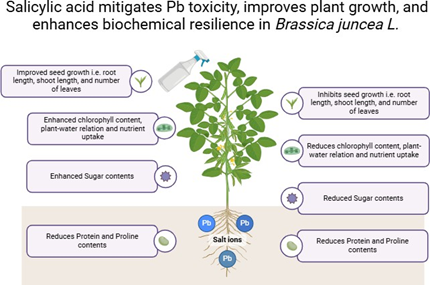Effects of Salicylic Acid Foliar Spray on Lead Stress Mitigation in Brassica juncea L.
Abstract
 Abstract Views: 0
Abstract Views: 0
Background. Heavy metal (HM) contamination has emerged as a pressing global concern, posing severe risks to all forms of life, including plants, animals, microorganisms, and aquatic ecosystems. The primary sources of HM pollution are various anthropogenic activities, such as industrial emissions, improper waste disposal, deforestation, urbanization, and overpopulation, as well as natural phenomena including volcanic eruptions. Lead (Pb) is a highly toxic HM, adversely affecting plant growth, development, and productivity.
Method. This study evaluates the effect of salicylic acid (SA) foliar spray on Brassica juncea L. under lead stress (10 ppm and 30 ppm concentrations).
Results. Lead stress significantly reduced root length (by 53-59%), chlorophyll content (chlorophyll a by 65-78%, chlorophyll b by 57-76%), and protein content (by 54-65%). However, salicylic acid application improved all parameters, including 24-30% increase in chlorophyll and 40% increase in protein content.
Conclusion. The findings highlight salicylic acid’s protective role in enhancing plant resilience and its potential as a practical approach to manage HM stress in contaminated soils.
Downloads
References
Sharma P. Role and significance of biofilm-forming microbes in phytoremediation: a review. Environ Technol Innov. 2022;25:e102182. https://doi.org/10.1016/j.eti.2021.1021 82
Tchounwou PB, Yedjou CG, Patlolla AK, Sutton DJ. Heavy metal toxicity and the environment. In: Luch A, ed.
Molecular, Clinical and Environmental Toxicology: Volume 3: Environmental Toxicology. 2012:133–
Gu YG, Ning JJ, Ke CL, Huang HH. Bioaccessibility and human health implications of heavy metals in different trophic level marine organisms: a case study of the South China Sea. Ecotoxicol Environ Saf. 2018;163:551–557. https://doi.org
/10.1016/j.ecoenv.2018.07.114
Li N, Euring D, Cha JY, et al. Plant hormone-mediated regulation of heat tolerance in response to global climate change. Front Plant Sci. 2021;11:e627969. https://doi.org
/10.3389/fpls.2020.627969
Malar S, Vikram SS, Favas PJC, Perumal V. Lead heavy metal toxicity- induced changes on growth and antioxidative enzymes level in water hyacinths [Eichhornia crassipes (Mart.)]. Bot Stud. 2014;55:e54. https://doi.org/10.1186/s40529-014- 0054-6
Lakra N, Tomar PC, Mishra SN. Growth response modulation by putrescine in Indian Mustard Brassica juncea L. under multiple stress. Indian J Exp Biol. 2016;54:262–270.
Kroukamp EM, Wondimu T, Forbes PBC. Metal and metalloid speciation in plants: overview, instrumentation, approaches, and commonly assessed elements. TrAC Trends Anal Chem. 2016;77:87–99. https://doi.org/ 10.1016/j.trac.2015.10.007
Pourrut B, Shahid M, Douay F, Dumat C, Pinelli E. Molecular mechanisms involved in lead uptake, toxicity, and detoxification in higher plants. In: Gupta DK, Corpas FJ, Palma JM, eds.
Heavy Metal Stress in Plants. Berlin, Heidelberg: Springer; 2013:1–242.
Lamhamdi M, El Galiou O, Bakrim A, et al. Effect of lead stress on mineral content and growth of wheat (Triticum aestivum) and spinach (Spinacia oleracea) seedlings. Saudi J Biol Sci. 2013;20:29–36. https://doi.org/10. 1016/j.sjbs.2012.09.001
Ali B, Mwamba TM, Gill RA, et al. Improvement of element uptake and antioxidative defense in Brassica napus under lead stress by application of hydrogen sulfide. Plant Growth Regul. 2014;74:261–273. https://doi. org/10.1007/s10725-014-9917-9
Kaur G, Singh HP, Batish DR, Kohli RK. Adaptations to oxidative stress in Zea mays roots under short-term Pb²⁺ exposure. Biologia. 2015;70:190–197. https://doi.org/10.1515/biolog-2015- 0023
Kushwaha A, Hans N, Kumar S, Rani
R. A critical review on speciation, mobilization, and toxicity of lead in soil-microbe-plant system and bioremediation strategies. Ecotoxicol Environ Saf. 2018;147:1035–1045.
https://doi.org/10.1016/j.ecoenv.2017. 09.049
Ahmad P, Sarwat M, Bhat NA, Wani MR, Kazi AG, Tran LSP. Alleviation of cadmium toxicity in Brassica juncea L. by calcium application involves various physiological and biochemical strategies. PLoS One. 2015;10(1):e0114571. https://doi.org/ 10.1371/journal.pone.0114571
Kasim WA, Abokassem EM, Ragab GA, Sewelam NA. Alleviation of lead stress toxicity in Vigna unguiculata by salicylic acid. Egypt J Exp Biol. 2014;10(1):37–49. https://doi.org/ 10.21608/egyseb.2023.200231
Madiha I, Bakht J, Shafi M, Rafi U. Screening of different Brassica species for phytoextraction of heavy metal from soil. Afr J Biotechnol. 2012;11:7649–7658.
https://doi.org/10.5897/AJB11.3223
Zhang H, Xu Z, Guo K, et al. Toxic effects of heavy metals Cd and Zn on chlorophyll, carotenoid metabolism, and photosynthetic function in tobacco leaves revealed by physiological and proteomics analysis. Ecotoxicol Environ Saf. 2020;202:e110856. https://doi.org/10.1016/j.ecoenv.2020. 110856
Arjeh E, Khodaei SM, Barzegar M, et al. Phenolic compounds of sugar beet (Beta vulgaris L.): separation method, chemical characterization, and biological properties. Food Sci Nutr. 2022;10(12):4238–4246.
https://doi.org/10.1002/fsn3.3017
Koper K, Hataya S, Hall AG, Takasuka TE, Maeda HA. Biochemical characterization of plant aromatic aminotransferases. In: Methods in Enzymology. Academic Press; 2023:35–83. https://doi.org
/10.1016/bs.mie.2022.07.034
Bates LS, Waldren RP, Teare ID. Rapid determination of free proline for water-stress studies. Plant Soil. 1973;39:205–207. https://doi.org/ 10.1007/BF00018060
Sharma A, Kohli SK, Khanna K, et al. Salicylic acid: a phenolic molecule with multiple roles in salt-stressed plants. J Plant Growth Regul. 2023;42(8):4581–4605. https://doi. org/10.1007/s00344-022-10902-z
Boulahia K, Said CO, Abrous- Belbachir O. Exogenous application of salicylic acid improves growth and some physio-biochemical parameters in herbicide-stressed Phaseolus vulgaris L. Gesunde Pflanzen. 2023;75(6):2301–2318. https://doi. org/10.1007/s10343-023-00878-5
Spoel SH, Dong X. Salicylic acid in plant immunity and beyond. Plant Cell. 2024;36(5):ekoad329. https://doi.org/10.1093/plcell/koad329
Gupta DK, Huang HG, Corpas FJ, Palma JM. Lead tolerance and toxicity in plants: role of ascorbate, glutathione, and phytochelatins in detoxification processes. J Hazard Mater. 2009;170(2-3):513–520.
Jahan A, Qaiser M, Khan MR. Salicylic acid mitigates lead-induced stress by improving chlorophyll and carotenoid contents and antioxidant activity in mustard plants (Brassica juncea L.). Ecotoxicology. 2016;25(3):630–642.
Khan MIR, Khan NA, Asgher M. Salicylic acid mitigates the adverse effects of lead toxicity in Brassica juncea. Environ Sci Pollut Res. 2015;22(7):5180–5193.
Kumar V, Rani S, Raghav R. Effect of salicylic acid on lead toxicity in Brassica juncea. Int J Plant Anim Environ Sci. 2012;2(1):146–150.
Mishra A, Kaur H, Singh P. Effect of lead on growth and biochemical parameters of Brassica juncea. Int J Environ Sci. 2016;6(2):438–447.
Khan MIR, Khan NA, Asgher M. Salicylic acid mitigates the adverse effects of lead toxicity in Brassica
juncea. Environ Sci Pollut Res.
;22(7):5180–5193.
Rastgoo M, Alemzadeh A. The effect of lead on the chlorophyll content and growth characteristics of Brassica juncea. J Environ Biol. 2011;32(4):491–494.
Nazar R, Iqbal N, Saqib M, Khan NA. Salicylic acid alleviates lead-induced oxidative stress in Brassica juncea. Environ Exp Bot. 2011;72(3):344–352.
Gautam A, Dubey RS. Metal toxicity in plants: induction of oxidative stress, antioxidative defense system, metabolic alterations, and phytoremediation. Mol Physiol Abiotic Stress Plant Prod. 2018:256–290.

Copyright (c) 2025 Naveen Dilawar, Muhammad Saifullah, Attaur Rahman, Muhammad Usman

This work is licensed under a Creative Commons Attribution 4.0 International License.
BSR follows an open-access publishing policy and full text of all published articles is available free, immediately upon publication of an issue. The journal’s contents are published and distributed under the terms of the Creative Commons Attribution 4.0 International (CC-BY 4.0) license. Thus, the work submitted to the journal implies that it is original, unpublished work of the authors (neither published previously nor accepted/under consideration for publication elsewhere). On acceptance of a manuscript for publication, a corresponding author on the behalf of all co-authors of the manuscript will sign and submit a completed the Copyright and Author Consent Form.









